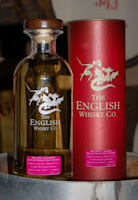 St. George's is the first whisky distillery to be built and produce whisky in England for almost 200 years. The distillery is located close to the town of Roudham in Norfolk and about 2 hours north east of London. The distillery is operated by The English Whisky Company, which was founded in 2005 by Andrew and James Nelstrop. The construction of the new facilities began shortly afterwards and the first spirit came off the stills in November 2006. The St. George's spirit is made from barley which is locally grown in Norfolk and they are currently producing and maturing whisky in peated and unpeated styles.
St. George's is the first whisky distillery to be built and produce whisky in England for almost 200 years. The distillery is located close to the town of Roudham in Norfolk and about 2 hours north east of London. The distillery is operated by The English Whisky Company, which was founded in 2005 by Andrew and James Nelstrop. The construction of the new facilities began shortly afterwards and the first spirit came off the stills in November 2006. The St. George's spirit is made from barley which is locally grown in Norfolk and they are currently producing and maturing whisky in peated and unpeated styles.This Chapter 7 whisky is made using unpeated malted barley and is released at three years of age. It has been finished for the final year in an ex-rum cask, after spending the first two years in ex-bourbon casks, and all future releases using this cask combination will also carry the Chapter 7 name. This first limited batch of just 660 bottles was released during in late Summer 2010 and has an alcoholic strength of 46% ABV. We thank David Fitt, the Chief Distiller at St. George’s for giving us this sample and for his time spent talking with us.
The other 'chapters' in the series are made up of new make spirit or partially aged spirit up to the age of three years (this is not legally allowed to be called 'whisky'), plus a number of three year old single malt whiskies that have been matured in various casks. Confused? We have listed each Chapter below to help, with links to the ones we have reviewed. The plan is to expand the range further as and when more stock reaches a suitable length of maturation. A bottle of Chapter 7 should cost £50-55, if you can still find one!
Definition of the St.George's Chapter series
Chapter 1 > Unpeated new make spirit
Chapter 2 > Peated new make spirit
Chapter 3 > Unpeated spirit matured for 18 months
Chapter 4 > Peated spirit matured for 18 months
Chapter 5 > First edition of three years old single malt
Chapter 6 > Unpeated three years old single malt
Chapter 7 > Unpeated three years old single malt with rum finish
Chapter 8 > First edition peated three years old single malt
Chapter 9 > Peated three years old single malt
Chapter 10 > Unpeated three years old single malt, sherry cask
Our tasting notes
The colour of this Chapter 7 is pale, almost lemon yellow. The nose is fresh, vibrant and youthful with an initial hit of tangy, sweet aromas - think of fresh green pears and apples, lemon zest and sugar cane. These are joined by notes of distinct cereal grain, something herbal (think of dried grass or hay) and a sawdust-like oakiness. Some white pepper spiciness and a hint of bitter cocoa powder compliment the other aromas very well. This is a very promising nose. On the palate, this whisky does not disappoint and is again light, fresh and vibrant. The obvious sweetness is prominent and driven by notes of fresh green pears and apples, icing sugar, honey and white chocolate. Other notes add balance - tangy lemon zest, cereal grains, oak, dried grasses and a white pepper spiciness that burns away in the background. The finish is short but is lovely, fresh and tangy. Again there is initial and intense sweetness, which has a mix of sugar cane syrup and sherbet to it. It then becomes dry and grassy right at the very end, which leaves your mouth watering and wanting more!
What's the verdict?
This is one of the best and most sympathetic uses of a rum cask that we have experienced in a whisky to date. The rum influence compliments the other characteristics and quality of the spirit, bringing a wonderful vibrancy and freshness. It makes you wonder - if The English Whisky Company's whiskies are this good now, then what will they be like with further time, maturation and experimentation? Chapter 7 is an excellent dram.
Please note > the photograph above is taken from www.englishwhisky.co.uk.

No comments:
Post a Comment